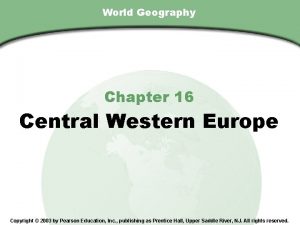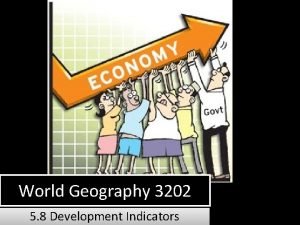World Geography 3202 Section 3 2 Relationships of









- Slides: 9

World Geography 3202: Section 3. 2 Relationships of Living and Non. Living Things are Delicately Balanced

Food Pyramid: Diagram showing each trophic level as a horizontal bar Producers are located on bottom & higher trophic levels are placed on top of each other Each bar is drawn in proportion to the mass of organisms. (Gives the triangle shape. Higher up the pyramid, the fewer the organisms. Why? )

Trophic Level It is a hierarchical level in an ecosystem. It is comprised of organisms that share the same function in the food chain and the same nutritional relationship to the primary sources of energy.

Why are there fewer organisms at each trophic level? 1 – 1. 5 Units 10 – 15 Units 100 – 150 units 1000 Units Less energy available at each level Fewer organisms can obtain energy to live. Therefore fewer organisms at increasing levels • Facts: • Only 10 – 15% of energy is transferred to the next level • 85 – 90% of energy is lost at each level!

Why is 85 -90% of Energy Lost? 1. Much of the energy is lost as heat 2. Alot of energy is used to carry out life functions. ie. we burn many calories of energy each day. So do all organisms 3. If an organism dies without being eaten, the energy goes to the decomposers, and not up the trophic levels Consequently only about 10 -15% of the energy is stored as usable food energy!

Why we do not often see a Fourth (quaternary) Trophic Level. Let’s use units of energy! Producer level: 1, 000 units of energy Primary consumers: Only have 100 -150 units of food energy stored for the next level. (Remember: 85 -90% is lost) Secondary consumers: Only have 10 -15 units of food energy stored for the next trophic level. (Remember: 85 -90% is lost) Tertiary consumers: Only have 1 -1. 5 units of food energy

Biological Amplification Biological amplification is the term used to describe the fact that higher trophic levels receive a higher dose of food chain toxins. This problem has occurred in our environment! The most common case was that of DDT, which was a pesticide used to control insect populations

How Pesticides can Reach Toxic Levels for Organisms at a Higher Trophic Level. 1. DDT is fat soluble and stays in an animals fat. (compared to water soluble toxins, which are excreted i. e. alcohol) 2. 3. Higher order organisms eat such large numbers of lower order organisms. A small amount in a frog becomes a large in a hawk, that eats 100 frogs.

Introduction of a New Organism: Upsetting the Balance Ecosystems are in a very delicate balance. Changing one thing in the ecosystem will have a domino effect through the system because of the relationships that exist.
 Chapter 16 world geography
Chapter 16 world geography World geography chapter 8 section 1
World geography chapter 8 section 1 World geography chapter 6 section 1
World geography chapter 6 section 1 Ap human geography frqs
Ap human geography frqs 5 themes of geography ap human geography
5 themes of geography ap human geography Ap human geography political geography test
Ap human geography political geography test Principles of ecology section 3 cycling of matter
Principles of ecology section 3 cycling of matter Chapter 2 section 1 organisms and their relationships
Chapter 2 section 1 organisms and their relationships Principles of ecology section 2 flow of energy
Principles of ecology section 2 flow of energy Chapter 2 principles of ecology answer key
Chapter 2 principles of ecology answer key

















